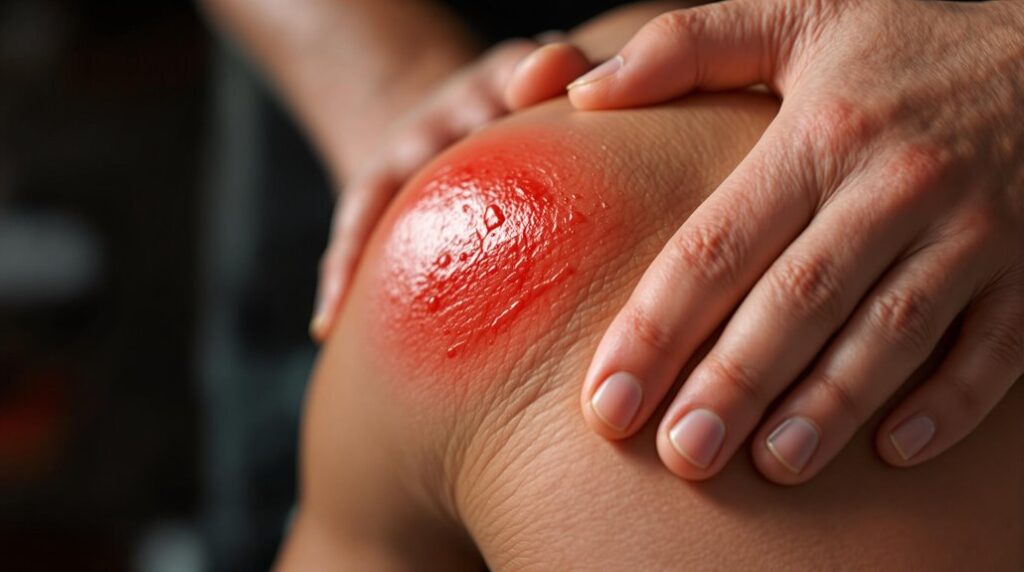Deep tissue massage accelerates sports injury recovery through five key mechanisms. It breaks down restrictive scar tissue and adhesions to restore range of motion, boosts circulation to deliver oxygen and nutrients to damaged areas, releases chronic muscle tension and knots, reduces inflammation through enhanced lymphatic drainage, and speeds up overall recovery time by up to 30%. Understanding these therapeutic benefits can help you make informed decisions about your rehabilitation strategy.
Breaking Down Scar Tissue and Adhesions
When scar tissue and adhesions develop following sports injuries, they can greatly impair an athlete's range of motion and performance capabilities. During deep tissue massage, your therapist will apply targeted pressure to break down these fibrous bands of tissue that have formed between muscles and fascia. You'll notice that the massage therapist uses various techniques, including friction and cross-fiber manipulation, to separate adhered tissue fibers and restore proper muscle function.
This process stimulates fibroblast activity, which helps remodel the scar tissue into more organized, flexible structures. You'll experience improved circulation to the affected areas as the massage breaks up these adhesions, allowing for better nutrient delivery and waste removal. The result is enhanced tissue elasticity and reduced pain, helping you return to your ideal athletic performance more quickly. Additionally, incorporating neuromuscular techniques can further enhance the recovery process by addressing underlying movement dysfunctions.
Increasing Blood Flow and Oxygen to Injured Areas
Through deep tissue massage techniques, your body experiences a significant boost in local blood circulation, delivering essential oxygen and nutrients to injured tissues. You'll notice improved healing as the massage strokes help dilate your blood vessels, allowing more red blood cells to reach damaged areas. This enhanced circulation doesn't just bring oxygen; it also carries crucial proteins and growth factors that accelerate tissue repair.
The increased blood flow helps remove metabolic waste products and reduces inflammation in your injured tissues. As your massage therapist applies targeted pressure, they're stimulating your body's natural healing mechanisms, which can speed up your recovery time by up to 30%. You'll also benefit from better lymphatic drainage, which helps clear cellular debris and excess fluid from the injury site. Additionally, improved circulation can enhance the body's healing process, allowing for a more effective recovery overall.
Releasing Muscle Tension and Chronic Knots
Deep tissue massage effectively targets muscle tension and chronic knots, working beyond the enhanced circulation benefits to address persistent muscular problems. You'll find that the massage therapist's focused pressure breaks down adhesions and scar tissue that have developed in your muscles, particularly in areas where you've experienced repetitive strain or injury.
The technique works by applying sustained pressure and slow strokes that reach deep into your muscle fibers, releasing stubborn knots known as trigger points. When these points are released, you'll notice improved range of motion and decreased muscle stiffness. The massage therapist will concentrate on specific problem areas, using their knuckles, forearms, and elbows to apply precise pressure that separates and lengthens your muscle fibers, helping to restore their natural elasticity and function. Additionally, sports massage is specifically designed to enhance performance and aid in recovery for athletes.
Reducing Post-Injury Inflammation
While your body naturally responds to injury with inflammation, deep tissue massage can effectively reduce this response by stimulating your lymphatic system and promoting faster healing. The targeted pressure applied during deep tissue massage helps flush out inflammatory chemicals and excess fluid that accumulate around injured tissues, which often cause pain and restricted movement.
You'll notice reduced swelling as the massage techniques encourage proper circulation and lymphatic drainage, allowing your body to clear cellular waste more efficiently. The massage therapist's precise movements break down adhesions while stimulating blood flow to damaged areas, which delivers essential nutrients and oxygen needed for repair. Additionally, you'll benefit from the release of anti-inflammatory compounds that naturally occur when deep pressure is applied to affected muscle groups, accelerating your body's healing processes.
Accelerating Muscle Recovery Time
Professional athletes and weekend warriors alike can benefit from the remarkable acceleration of muscle recovery that deep tissue massage provides. You'll experience faster healing as the targeted pressure increases blood flow to damaged tissues, delivering essential nutrients and oxygen while removing metabolic waste products that slow recovery.
The massage's mechanical action breaks down adhesions and scar tissue, which enables your muscles to repair more efficiently. Studies show that athletes who receive deep tissue massage within 48 hours of intense training can reduce their recovery time by up to 30%. Your body's natural healing processes are enhanced through the stimulation of mitochondrial biogenesis, leading to improved muscle fiber regeneration. This acceleration in recovery means you can return to training sooner while maintaining proper tissue health and reducing the risk of re-injury. Additionally, understanding ankle injury signs can further aid in the prevention of future injuries while undergoing recovery.

